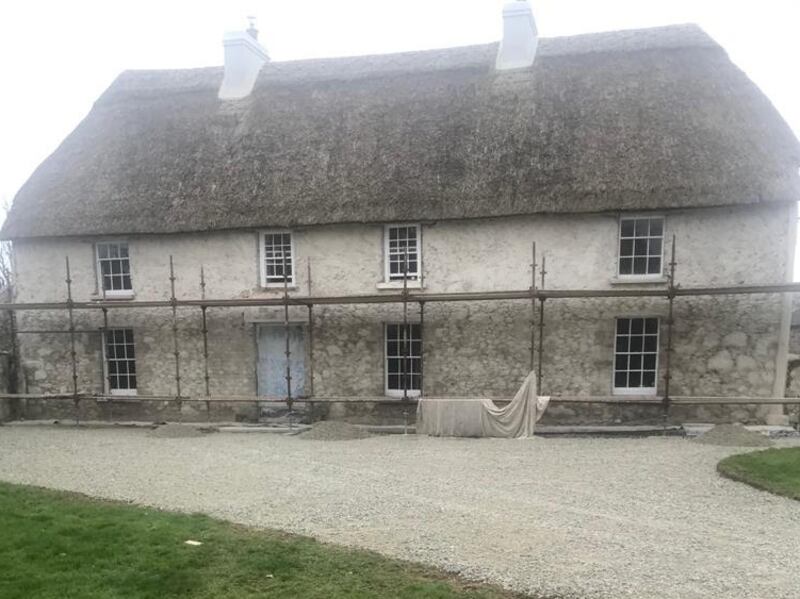“Hello.”
“Hi Steve, are you still working?”
“No Mam, I finished a little while ago. All okay?”
“Yeah, big progress in the house today ... though the bathroom wall did collapse.”
Qatar hosts Arab summit over Israeli strike on Hamas leaders in Doha
‘I can’t believe we’re living here’: Historic Wexford cottage that was at risk of falling into decline is restored
‘The bathroom wall just collapsed’: A first-time homeowner’s renovation project
‘I feared losing every penny I’d saved for 20 years’: A first-time homeowner’s renovation project
“Oh ...”
Living a safe distance from a home renovation project in which you’re heavily invested is a right pain in some respects, but has advantages in others.
Many things you’d rather not have come to pass do, inevitably. A wall falls down, a ceiling, or four you’d not budgeted to replace, need replacing or a section of wall you’d spent ages chipping the plaster off (as the bricks that doing so revealed would look really well as a feature of sorts) is replastered without your knowledge.
But by the time you return to the frontline and see what seemed like a disaster when you initially heard about it, there is usually something else that has changed – generally but not always for the better, to provide some distraction.
This realisation dawned once the annoying issues that had delayed drawing down the mortgage for several months were sorted. The money troubles had eased, I was sleeping semi-soundly again and no new or significantly expensive gremlins were raising their heads. Things appeared to be taking shape, we were in a more enjoyable phase of the job and I was learning to roll with the punches.
The works we’d secured planning approval for – changing the roof on the rear extension and knocking down the front porch – were completed, the former being one of those rare and wonderful things that came in under budget.
We’d feared that the front of the house might appear a bit naked without the porch, but the new door looked well when lined up alongside the refurbished sash windows. A nice splash of colour (whenever a shade of paint for the door is agreed upon) should further add to the facade.
The ground level around the house was lowered and a French drain was dug out to divert rain and groundwater elsewhere in an attempt to prevent a repeat of the past damp/rot problems, the upshot of which was essentially the catalyst for this entire endeavour.

We looked into restoring the seriously rusted Rayburn range. Given the extent of the decay to the frame (those scorch marks on the tiled kitchen wall behind it didn’t come out of nowhere) the quote came in at almost €5,000, ultimately for something that wasn’t a necessity. We decided to move forward without.
When planning out the kitchen we opted to convert the alcove where the range previously sat into a pantry. This allowed scope to place the sink, new cooker and all the rest in a straight line along the opposite wall, and spared us the need to put in a row of high storage cabinets.
The window shutters were reinstated and the main stairs proved to be in reasonably good shape, with the exception of the bottom two steps which needed to be replaced. We decided that making use of a smaller set of steps, which ran off the turn of the stairs but had been blocked off by a floating floor for as long as I could remember, presumably because they were very steep and quite hazardous, could help to provide a solution to another problem.
Eighteenth-century homes were not built with “facilities” in mind and we were keen to avoid having a long trek from the upstairs bedrooms (down a storey, through the hall and livingroom and out into the rear extension) to the toilet. The collapse of one of the aforementioned ceilings offered the scope and space required to put in a significantly less treacherous set of steps up to what will eventually serve as an upstairs bathroom.
Some of the furniture we’d put into storage while the works went on has been restored – and shined up really well. There are two lovely bed frames, two old dressers that were converted into bathroom vanities, an ornate coffee table from India (where my great aunt had lived as a nun), wardrobes and a kitchen table. These will go back into the house right away and there is a heap of other old bits and bobs that we will get to cleaning up and finding a place for at some point. It is satisfying to see the sanding, filling, varnishing and priming pay off, but it is painstakingly slow work.
More painful than painstaking was making decisions on things I had never needed to think about at any other point in my life. I spent weeks (maybe months) looking at baths on various websites in my spare time. Then, after one was settled on we learned it wouldn’t be back in stock until a time to be established, if ever. Another option was soon selected, bought and, hopefully, we’ll never have to look at them again.
Picking tiles and flooring was also a time sink. We visited a store recommended by the contractor and chose what then seemed an ideal array for the bathrooms, hallway floor and kitchen.
We went back a few weeks later to make sure we were happy with our well-thought-out choices before pulling the trigger and buying them and, of course, realised we most certainly were not.
Blue turned to green and flat designs became patterns as an almost entirely different selection was agreed upon. These were bought in haste to try to spare another round of selection anxiety and second-guessing. I’ll live with any future bouts of buyer’s remorse.
These preludes suggest that choosing paint colours is unlikely to be fun either, but sure won’t it be great to get to that point.












